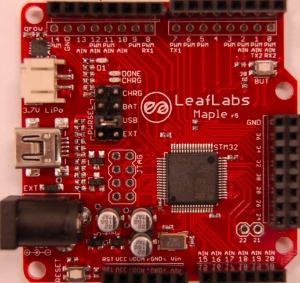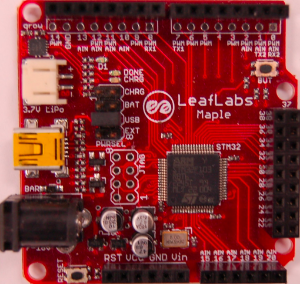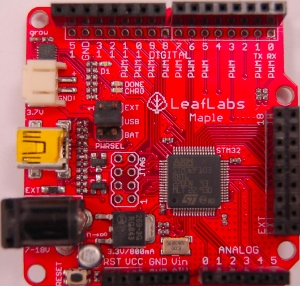Maple¶
Contents
Technical Specifications¶
- MCU: STM32F103RBT6, a 32-bit ARM Cortex M3 microprocessor
- Clock Speed: 72 MHz
- 128KB Flash and 20KB SRAM
- 44 Digital I/O Pins (GPIO)
- 16 Analog Input Pins, 12-bit ADC resolution (ADC)
- 15 PWM pins at 16-bit resolution (PWM)
- Dedicated USB port for programming and communications (USB)
- External JTAG interface (JTAG)
- 64 Channel nested vector interrupt handler (including external interrupt on GPIOs)
- Integrated SPI (SPI)
- Integrated I2C (I2C)
- 7 Channels of Direct Memory Access (DMA) (libmaple.dma)
- 3 USART divices (USART)
- Four 4-channel timers (Timers)
- Supplies up to 500mA @ 3.3v (with separate 250 mA digital and analog regulators)
- Support for low power, sleep, and standby modes (<500uA)
- Operating Voltage: 3.3V
- Input Voltage (recommended): 3V-12V
- Dimensions are 2.05″x2.1″
Identifying your Rev¶
We went through three versions (“Revs”) of the Maple hardware: Rev 1, Rev 3, and Rev 5 [1]; Rev 5, the final design, is currently on sale. The following sections will help you to help you identify your Rev.
Rev 5¶
These boards went on sale in November 2010. They have white buttons, and “r5” in small print near the “LeafLabs Maple” text next to the “infinity leaf” logo. The Maple Rev 5 repositioned the double header on the right hand side to better fit 0.1 inch pitch breadboard. This necessitated the removal of pins 21 and 22 from the double header; they are still available, but don’t have any headers installed on them.

Powering the Maple¶
The Maple’s power source is determined by the header to the left of the “LeafLabs” label on the silkscreen. All versions of the Maple can be powered from the barrel jack connector, USB, or a LiPo battery. We ship the Maple with a jumper on the USB selector. In order to power it off of an alternative source, unplug the Maple, then move the jumper to the desired selector before reconnecting power.
You can also power the Maple via the pin labeled “Vin” on the lower header. However, don’t do this while simultaneously powering the Maple from another source, or you could damage the board.
Using the Built-in Battery Charger¶
Maples Rev 3 and Rev 5 also have a built-in LiPo battery charger. In order to use it, put a jumper across the CHRG header on the power selection header and across the USB, or EXT selectors, depending on whether you’re charging the battery via USB cable or barrel jack connector. The LED labeled CHRG will light up while the battery is being charged. When the battery is finished charging, the LED labeled DONE will also light up.
GPIO Information¶
The Maple features 38 ready-to-use general purpose input/output (GPIO) pins for digital input/output, numbered D0 through D37. These numbers correspond to the numeric values next to each header on the Maple silkscreen. More GPIOs (numbered D39–D43) are available through use in combination with the disableDebugPorts() function; see the board-specific debug pin constants for more information.
Master Pin Map¶
This table shows the available functionality on every GPIO pin, by peripheral type. The “STM32” column refers to the port and number that the header is connected to on the microcontroller. The “5V?” column documents whether or not the pin is 5 volt tolerant.
| Pin | STM32 | ADC | Timer | I2C | UART | SPI | 5v? |
|---|---|---|---|---|---|---|---|
| D0 | PA3 | ADC3 | TIM2_CH4 | USART2_RX | No | ||
| D1 | PA2 | ADC2 | TIM2_CH3 | USART2_TX | No | ||
| D2 | PA0 | ADC0 | TIM2_CH1_ETR | USART2_CTS | No | ||
| D3 | PA1 | ADC1 | TIM2_CH2 | USART2_RTS | No | ||
| D4 | PB5 | ISC1_SMBA | No | ||||
| D5 | PB6 | TIM4_CH1 | I2C1_SCL | Yes | |||
| D6 | PA8 | TIM1_CH1 | USART1_CK | Yes | |||
| D7 | PA9 | TIM1_CH2 | USART1_TX | Yes | |||
| D8 | PA10 | TIM1_CH3 | USART1_RX | Yes | |||
| D9 | PB7 | TIM4_CH2 | I2C1_SDA | Yes | |||
| D10 | PA4 | ADC4 | USART2_CK | SPI1_NSS | No | ||
| D11 | PA7 | ADC7 | TIM3_CH2 | SPI1_MOSI | No | ||
| D12 | PA6 | ADC6 | TIM3_CH1 | SPI1_MISO | No | ||
| D13 | PA5 | ADC5 | SPI1_SCK | No | |||
| D14 | PB8 | TIM4_CH3 | Yes | ||||
| D15 | PC0 | ADC10 | No | ||||
| D16 | PC1 | ADC11 | No | ||||
| D17 | PC2 | ADC12 | No | ||||
| D18 | PC3 | ADC13 | No | ||||
| D19 | PC4 | ADC14 | No | ||||
| D20 | PC5 | ADC15 | No | ||||
| D21 | PC13 | No | |||||
| D22 | PC14 | No | |||||
| D23 | PC15 | No | |||||
| D24 | PB9 | TIM4_CH4 | Yes | ||||
| D25 | PD2 | TIM3_ETR | Yes | ||||
| D26 | PC10 | Yes | |||||
| D27 | PB0 | ADC8 | TIM3_CH3 | No | |||
| D28 | PB1 | ADC9 | TIM3_CH4 | No | |||
| D29 | PB10 | I2C2_SCL | USART3_TX | Yes | |||
| D30 | PB11 | I2C2_SDA | USART3_RX | Yes | |||
| D31 | PB12 | TIM1_BKIN | I2C2_SMBA | USART3_CK | SPI2_NSS | Yes | |
| D32 | PB13 | TIM1_CH1N | USART3_CTS | SPI2_SCK | Yes | ||
| D33 | PB14 | TIM1_CH2N | USART3_RTS | SPI2_MISO | Yes | ||
| D34 | PB15 | TIM1_CH3N | SPI2_MOSI | Yes | |||
| D35 | PC6 | Yes | |||||
| D36 | PC7 | Yes | |||||
| D37 | PC8 | Yes |
Timer Pin Map¶
The following table shows what pins are associated with a particular timer’s capture/compare channels.
| Timer | Ch. 1 | Ch. 2 | Ch. 3 | Ch. 4 |
|---|---|---|---|---|
| 1 | D6 | D7 | D8 | |
| 2 | D2 | D3 | D1 | D0 |
| 3 | D12 | D11 | D27 | D28 |
| 4 | D5 | D9 | D14 | D24 |
EXTI Line Pin Map¶
The following table shows which pins connect to which EXTI lines on the Maple.
| EXTI Line | Pins |
|---|---|
| EXTI0 | 2, 15, 27 |
| EXTI1 | 3, 16, 28 |
| EXTI2 | 1, 17, 25 |
| EXTI3 | 0, 18 |
| EXTI4 | 10, 19 |
| EXTI5 | 4, 13, 20 |
| EXTI6 | 5, 12, 35 |
| EXTI7 | 9, 11, 36 |
| EXTI8 | 6, 14, 37 |
| EXTI9 | 7, 25, 28 |
| EXTI10 | 8, 26, 29 |
| EXTI11 | 30 |
| EXTI12 | 31 |
| EXTI13 | 21, 32 |
| EXTI14 | 22, 33 |
| EXTI15 | 23, 34 |
USART Pin Map¶
The Maple has three serial ports (also known as a UARTs or USARTs): Serial1, Serial2, and Serial3. They communicate using the pins summarized in the following table:
| Serial Port | TX | RX | CK | CTS | RTS |
|---|---|---|---|---|---|
| Serial1 | 7 | 8 | 6 | ||
| Serial2 | 1 | 0 | 10 | 2 | 3 |
| Serial3 | 29 | 30 | 31 | 32 | 33 |
Board-Specific Values¶
This section lists the Maple’s board-specific values.
- CYCLES_PER_MICROSECOND: 72
- BOARD_BUTTON_PIN: 38
- BOARD_LED_PIN: 13
- BOARD_NR_GPIO_PINS: 44
- BOARD_NR_PWM_PINS: 16
- boardPWMPins: 0, 1, 2, 3, 5, 6, 7, 8, 9, 11, 12, 14, 24, 25, 27, 28
- BOARD_NR_ADC_PINS: 15
- boardADCPins: 0, 1, 2, 10, 11, 12, 13, 15, 16, 17, 18, 19, 20, 27, 28
- BOARD_NR_USED_PINS: 7
- boardUsedPins: BOARD_LED_PIN, BOARD_BUTTON_PIN, BOARD_JTMS_SWDIO_PIN, BOARD_JTCK_SWCLK_PIN, BOARD_JTDI_PIN, BOARD_JTDO_PIN, BOARD_NJTRST_PIN
- BOARD_NR_USARTS: 3
- BOARD_USART1_TX_PIN: 7
- BOARD_USART1_RX_PIN: 8
- BOARD_USART2_TX_PIN: 1
- BOARD_USART2_RX_PIN: 0
- BOARD_USART3_TX_PIN: 29
- BOARD_USART3_RX_PIN: 30
- BOARD_NR_SPI: 2
- BOARD_SPI1_NSS_PIN: 10
- BOARD_SPI1_MOSI_PIN: 11
- BOARD_SPI1_MISO_PIN: 12
- BOARD_SPI1_SCK_PIN: 13
- BOARD_SPI2_NSS_PIN: 31
- BOARD_SPI2_MOSI_PIN: 34
- BOARD_SPI2_MISO_PIN: 33
- BOARD_SPI2_SCK_PIN: 32
- BOARD_JTMS_SWDIO_PIN: 39
- BOARD_JTCK_SWCLK_PIN: 40
- BOARD_JTDI_PIN: 41
- BOARD_JTDO_PIN: 42
- BOARD_NJTRST_PIN: 43
Hardware Design Files¶
The hardware schematics and board layout files are available in the Maple Github repository. The design files for Rev 1, Rev 3, and Rev 5 are respectively in the maple-r1, maple-r3, and maple-r5 subdirectories. A schematic for a JTAG adapter suitable for use with Maple is available in the jtagadapter directory.
From the GitHub repository main page, you can download the entire repository by clicking the “Download” button. If you are familiar with git, you can also clone the repository at the command line with
$ git clone git://github.com/leaflabs/maple.git
Failure Modes¶
The following are known failure modes. The failure modes aren’t design errors, but are easy ways to break or damage your board permanently.
- High voltage on non-tolerant pins: not all header pins are 5V compatible; so e.g. connecting certain serial devices in the wrong way could over-voltage the pins. The pin-mapping master table details which pins are 5V-tolerant.
Errata¶
General¶
- Power Supply Marketing Mistake: We originally sold the Maple advertising that it was capable of supplying up to 800 mA; the correct value is 500 mA.
By Rev¶
The following subsections lists known issues and warnings for each revision of the Maple board.
Rev 5¶
- Pin 3 AIN missing: Pin 3 is capable of analog input, but on Rev 5s manufactured during Fall 2010, the corresponding “AIN” is missing from its silkscreen. This mistake was fixed in later manufacturing runs.
- Reset and NJTRST tied together: The MCU’s reset pin is connected to PB4, the NJTRST pin, which is pin 43. Thus, attempting to use pin 43 as a GPIO will reset your board (and also prevents the JTAG “reset halt”) command from working properly.
Rev 3¶
- Pin 3 AIN missing: Pin 3 is capable of analog input, but the corresponding “AIN” is missing from the Rev 3 silkscreen.
Rev 1¶
ADC noise: generally very high, in particular when the USB port is being used for communications (including keep-alive pings when connected to a computer).
This issue was resolved in Rev 3 with a 4-layer design and a geometrically isolated ADC Vref plane.
Resistors on pins 0 and 1: these header pins, which are RX/TX on USART2 (Serial2), have resistors in-line between the STM32 and the headers. These resistors increase the impedance of the lines for ADC reads and affect the open drain GPIO functionality of the pins.
These resistors were accidentally copied over from older Arduino USB designs, where they appear to protect the USB-Serial converter from TTL voltage on the headers.
Silkscreen Differences: the pin numbering scheme on Rev 1 is different from Rev 3, and thus Rev 3 software is difficult to use with Rev 1 boards. Notably, the analog input bank is labeled A0-A4 on Rev 1 but 15-20 on Rev 3, and the extra header bank does not have a pinout table on the bottom.
No BUT Button: the BUT button, useful for serial bootloading, was only added in Rev 3. As a workaround, you can directly short the appropriate MCU pin to Vcc; see this forum posting.
PWM Marketing Mistake: We originally sold the Maple advertising 22 channels of 16-bit hardware PWM; the correct number is 15.
Reset and NJTRST tied together: The MCU’s reset pin is tied to PB4, the NJTRST pin, which is pin 43. Thus, attempting to use pin 43 as a GPIO will reset your board (and also prevents the JTAG “reset halt”) command from working properly. It’s possible to cut the trace, but doing so will damage your board, so we do not recommend it unless you’re very sure about what you’re doing.
Recommended Reading¶
STMicro documentation for STM32F103RB microcontroller:
- Datasheet (PDF)
- Reference Manual (PDF)
- Programming Manual (PDF; assembly language and register reference)
Footnotes
| [1] | Revs 2 and 4 were prototypes that didn’t pass internal testing. |


